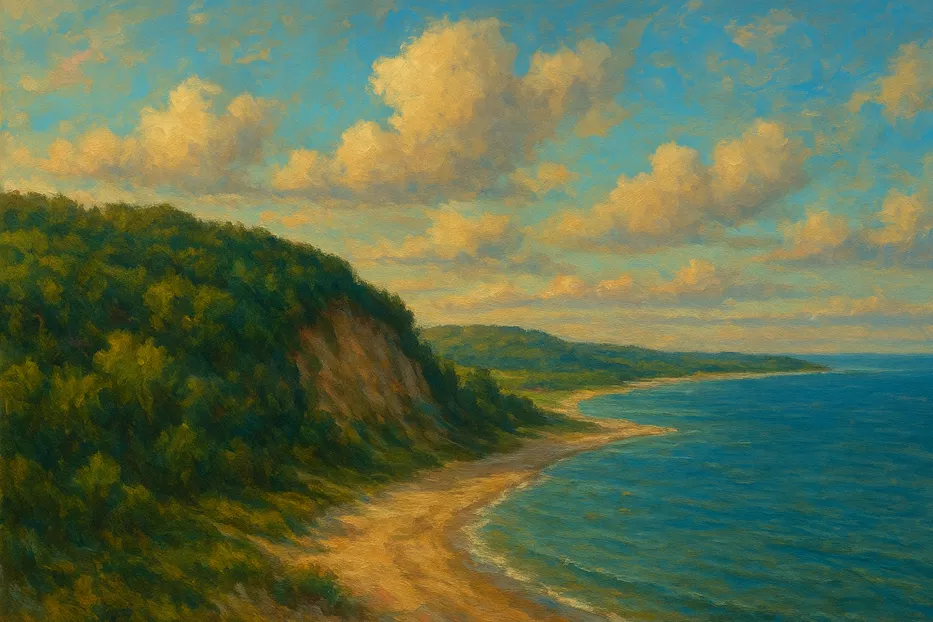Wolin is the largest island in Poland, located in the north-west of the country between the Baltic Sea and the Szczecin Lagoon.
Known for its dramatic cliffs, pristine beaches, and rich cultural heritage, Wolin combines natural beauty with centuries of history. This guide explores the island’s top attractions, practical travel information, and reasons why Wolin is one of the most distinctive destinations on Poland‘s Baltic coast.
Table of Contents
Geography and Natural Landscapes
Covering around 265 square kilometers (102 square miles), Wolin lies in the West Pomeranian Voivodeship. Its coastline alternates between wide sandy beaches and steep cliffs that rise up to 80 meters (262 feet) at Gosań and Kawcza Góra. The island is famous for Wolin National Park, which protects forests, wetlands, dunes, and rare wildlife such as white-tailed eagles and bison. Visitors will also find several glacial lakes, including Turquoise Lake (Jezioro Turkusowe), whose unique color comes from dissolved minerals.
The island’s central spine consists of morainic hills, making it more varied in elevation than most Baltic islands. The mixture of forest trails, viewpoints, and seashore makes Wolin a prime destination for hiking and cycling.
Wolin National Park
Established in 1960, Wolin National Park occupies the northern part of the island and stretches across 109 square kilometers 42 square miles). The park is known for its beech and pine forests, coastal cliffs, and bird habitats. Popular hiking routes lead to viewpoints such as Kawcza Góra and Gosań, offering panoramic views of the Baltic. The park also maintains a European bison reserve, where visitors can observe bison, wild boar, and deer in semi-natural conditions.

For nature enthusiasts, the park’s wetlands host numerous bird species, making it a key stop for birdwatching on the Baltic migratory route.
Beaches and Coastal Attractions
The largest island in Poland offers several beaches, the most popular located near Międzyzdroje, a resort town on the island’s north shore. These sandy stretches are equipped with boardwalks and facilities, attracting both families and swimmers. Beyond Międzyzdroje, quieter beaches can be found near Wisełka and Grodno, where the setting is more natural and less developed.
The island’s cliffs add a dramatic backdrop, unusual for the generally flat Polish coast. Sunsets viewed from the cliffs near Międzyzdroje are among the most striking coastal panoramas in the region.
History and Cultural Heritage
Wolin has been inhabited since the early Middle Ages and was once the site of a major Slavic trading settlement. Archaeological findings suggest the town of Wolin may correspond to the legendary Vineta, sometimes called the “Atlantis of the Baltic.” Today, the island preserves this heritage through the Wolin Archaeological Museum and the annual Festival of Slavs and Vikings, one of the largest historical reenactments in Europe.
The town of Wolin, located in the south of the island, features medieval churches and remnants of fortifications. Visitors interested in history can follow local trails connecting Viking-era sites with later periods of Pomeranian and Polish rule.
Towns and Villages
- Międzyzdroje – The main resort on the island, known for its beaches, pier, and the Avenue of Stars, a promenade featuring plaques of Polish actors.
- Wolin Town – Smaller and more historic, with museums and archaeological sites.
- Wisełka and Grodno – Peaceful villages close to lakes and forests, ideal for outdoor activities.
Outdoor Activities
The largest island in Poland is ideal for active travel. Hiking trails lead across the cliffs and through the forests of Wolin National Park. Cycling routes connect seaside resorts with inland lakes. Kayaking is possible on rivers and lagoons, while birdwatchers find rich opportunities in coastal wetlands.
Anglers are drawn to the Szczecin Lagoon and local lakes, where pike and perch are common catches.
Getting There and Around
The island is connected to the mainland by road and rail. The town of Świnoujście, located partly on Wolin, is a gateway for travelers arriving by ferry from Sweden or Germany. Regional trains link Wolin with Szczecin, while local buses connect towns and villages across the island. For flexibility, renting a car or bicycle is recommended.
Why Visit Wolin
Wolin combines unspoiled landscapes with cultural depth. It offers Poland’s only coastal cliffs, extensive national parkland, and a heritage rooted in early Slavic history. Unlike crowded resorts elsewhere, many parts of Wolin remain quiet, making it a destination for both relaxation and active exploration.
For travelers seeking an authentic blend of Baltic nature and history, the largest island in Poland stands out as one of the most rewarding islands in Northern Europe.

